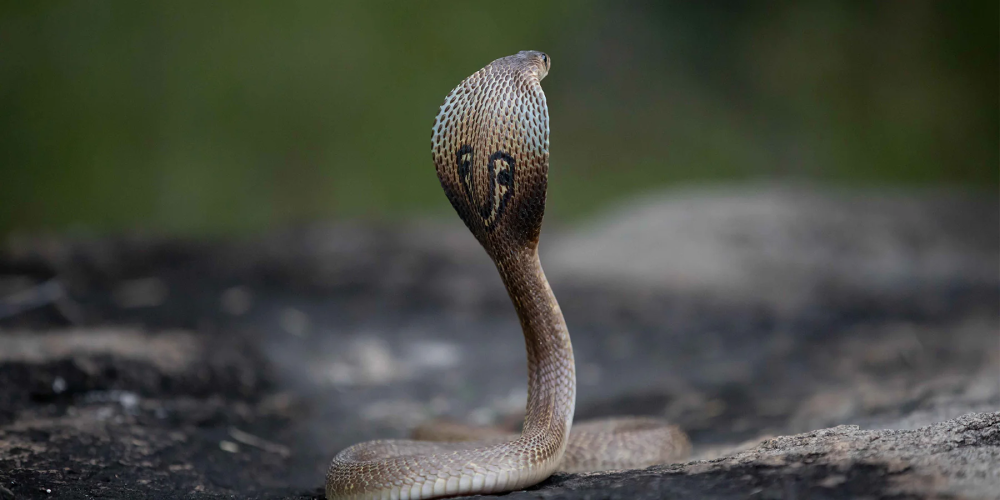The King Cobra (Ophiophagus hannah) is one of the most iconic and feared serpents in the world. Known for its imposing size, potent venom, and distinctive hood, the King Cobra occupies a prominent place in both natural ecosystems and human folklore. This article explores the biology, behavior, habitat, conservation status, and cultural significance of this remarkable reptile.
Biology and Physical Characteristics
The King Cobra is the longest venomous snake in the world. With adults typically it is ranging between 10 to 13 feet (3 to 4 meters) in length. Exceptionally large individuals can reach lengths of up to 18 feet (5.5 meters). Their size also has a robust and muscular build. The coloration of King Cobras varies but generally features olive-green, tan, or black scales, often with light bands on the body. The most recognizable feature of the King Cobra is its hood, which it can flare out when threatened. This hood is created by the extension of the ribs behind the snake’s head, presenting a more intimidating profile to potential threats.
The venom of the King Cobra is a potent neurotoxin, affecting the respiratory centers of the brain, leading to respiratory arrest and cardiac failure. Unlike many other venomous snakes that deliver a quick, lethal bite, the King Cobra often administers a larger quantity of venom in a single bite, which is capable of killing an elephant or 20 humans. True to its genus name, Ophiophagus, which means “snake-eater,” the King Cobra predominantly preys on other snakes, including both venomous and non-venomous species. It also hunts lizards, birds, and small mammals. King Cobras are active hunters, utilizing their keen eyesight and highly developed sense of smell to track and ambush prey.

Behavior and Reproduction
King Cobras are solitary animals, highly territorial, and known to be fiercely protective of their domain. They often engage in combat with rival males during the mating season, using their size and strength to establish dominance. Unlike most snakes, the King Cobra exhibits a unique nesting behavior. Females construct nests out of leaf litter and other debris, where they lay between 20 to 50 eggs. The female remains with the nest, guarding it aggressively until the eggs hatch, which takes about 60 to 90 days. This level of parental care is unusual among reptiles and highlights the species’ complex behavior.
Habitat and Distribution
King Cobras are native to the forests of Southeast Asia, including India, Bangladesh, Myanmar, Thailand, Laos, Cambodia, Vietnam, Malaysia, Indonesia, and the Philippines. They inhabit a range of environments from lowland forests and bamboo thickets to mangrove swamps and high-altitude grasslands. King Cobras prefer dense, moist forests where they can find ample cover and prey. They often live near bodies of water, such as rivers and lakes, which support a diverse range of potential prey species. Despite their adaptability, habitat destruction and deforestation pose significant threats to their populations.
Conservation Status
The King Cobra is listed as Vulnerable on the IUCN Red List. The primary threats to its survival include habitat loss, human-wildlife conflict, and exploitation for the pet trade and traditional medicine. Conservation efforts are focused on habitat preservation, public education, and reducing human-wildlife conflicts through community engagement and mitigation strategies.
Cultural Significance
The King Cobra holds a revered place in the mythology and folklore of many cultures across its range. In India, it is associated with the god Shiva and is often depicted in Hindu art and sculpture. In Southeast Asia, the King Cobra is a symbol of power and protection, and its image is used in various traditional practices and rituals.
Conclusion
The King Cobra is a remarkable example of evolutionary adaptation and ecological significance. Its impressive size, potent venom, and unique behaviors make it a subject of fascination and respect. Protecting this apex predator is crucial for maintaining the health and balance of the ecosystems it inhabits. Through concerted conservation efforts and increased awareness, the future of the King Cobra can be secured, ensuring that this majestic serpent continues to thrive in the wild.









